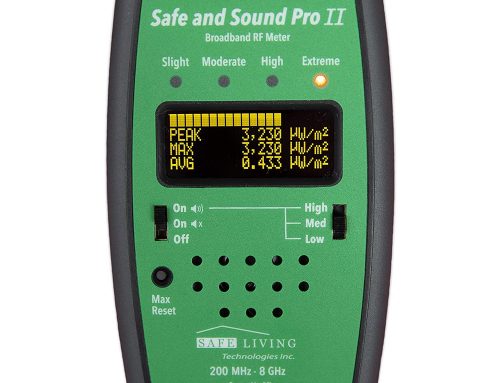Say you’re already on the low-EMF bandwagon…
You’re feeling great about the lifestyle changes that you’ve made. Perhaps you are sleeping more soundly, concentrating better, your ears are no longer ringing, and your head no longer tingles since you’ve stopped holding your phone to your ear when making calls.
You’re ready to share your newfound enthusiasm with others.
But they’ve never heard of the low-EMF movement for health and well-being. How do you bring it up?
Here’s what I do:
Start by sharing the Sage Living EMF fact sheet with them. It contains good information to start the conversation.
It also contains a ton of low-EMF tips that are easy to implement. Pick one to start. For example:
Do you like to keep your phone on your nightstand? Put it on airplane mode every night before you go to sleep.
Are you always on the phone? Use the wired headphones that come with your phone.
Do your children like to watch movies on your phone? Download the content first and activate airplane mode before giving it to your kids.
And here’s the biggie. Why should we care? Why is reducing your EMF exposure important?
Here’s the science to make you reconsider putting your phone next to your head.
EMF stands for electromagnetic fields. For thousands of years, humans have evolved with naturally occurring EMF frequencies that are present on Earth and in space. Modern life has introduced all kinds of artificial EMF (think wireless devices, electrical power lines and appliances, etc). At levels that are now common in daily life, these sources can overwhelm the body with unnatural EMFs. EMF exposure can cause symptoms that include insomnia, headaches, dizziness, fatigue, memory problems and immune system dysfunction.
One type of EMF, called radio frequency radiation, is classified by the World Health Organization as a possible carcinogen (a cancer-causing agent) based, in part, on the increased risk of glioma (malignant brain cancer) from wireless phone use.
Today brain cancer is the most common cancer among children and adolescents (source: American Brain Tumor Association, Dec 2015).
During 1999–2014, brain cancer replaced leukemia as the most common cancer causing death in children and adolescents (source: CDC, Sept 2016).
Children’s brains absorb 2x the radiation from a cell phone compared to adults (source: Ghandi et al, 2012).
88% of 13-17 year olds in US have cell phones. 73% have smartphones, (source: Pew Research Center 2015).
47% of US households are wireless only (no landline telephone). (source: NHIS. NCHS, CDC. Dec., 2015).
In May 2016, the U.S. National Toxicology Program (NTP) announced that its recently completed study showed statistically significant increases in cancer among rats that had been exposed to cell phone radiation for two years. (source: Microwave News, May 2016).
While the overall rate of brain cancer has remained relatively static since the 1990’s, there’s more to the story if you look closely.
A team of researchers from the University of Southern California Medical School in Los Angeles looked at the incidence of brain tumors in three “major cancer registries” over a 15-year period (1992-2006). In a paper published in 2012, they reported that glioblastoma multiformes (GBMs) had gone up while the other types had gone down. The study showed “decreased rates of primary brain tumors in all sites with the notable exception of increased incidence of GBM in the frontal lobes, temporal lobes and cerebellum.”
The increase in GBMs in the temporal lobe (the region of the brain closest to the ear and potentially to a phone) was seen in all three registries, ranging from approximately 1.3% to 2.3% per year, a finding that is statistically significant. (source: Microwave News, Sept 2016.)
Of the 17,000 cases of brain tumors diagnosed each year, 60% are gliomas. The most aggressive form of this type of tumor is glioblastoma which is particularly deadly and has no cure. Even with optimal treatment, the median survival is less than one year. Long term survivors are rare. (source: Walid, 2008).
In the modern world, we live in a haze of radio frequency radiation emitted by our mobile phones, but also by our wireless networks and any device (tablets, bluetooth, etc.) that has wireless connectivity.
We are a test generation for wireless devices. It is entirely possible that there may be other unknown factors contributing to these statistics. But until federal safety regulations catch up to the advances in wireless technology, we advocate taking a precautionary approach to wireless use and adopting a less-is-more philosophy when it comes to technology, especially for children.
And if you’ve embraced the low-EMF movement, even in small steps, be proud of what you accomplished!





